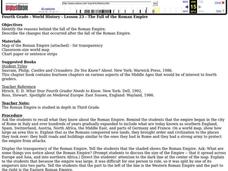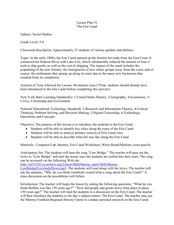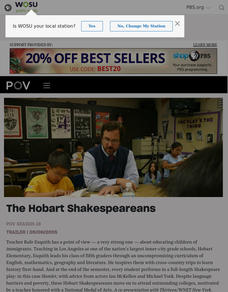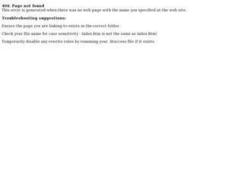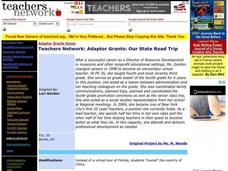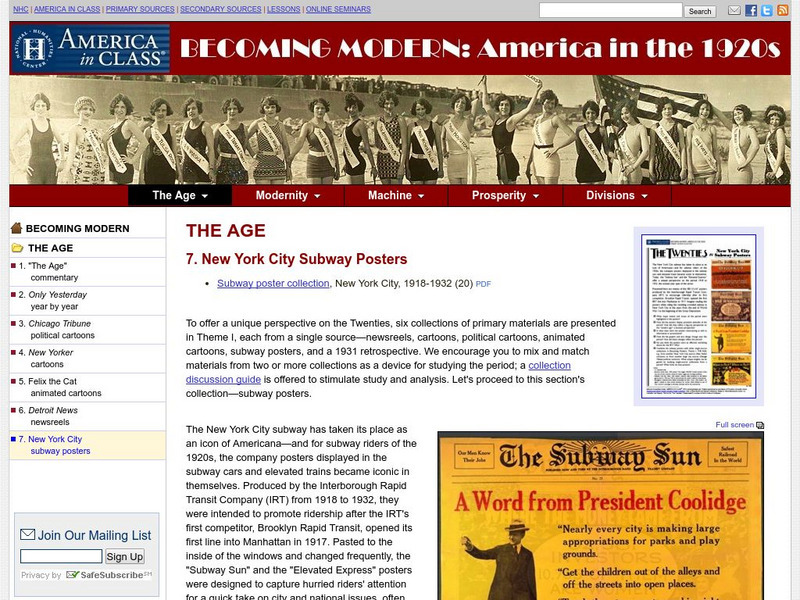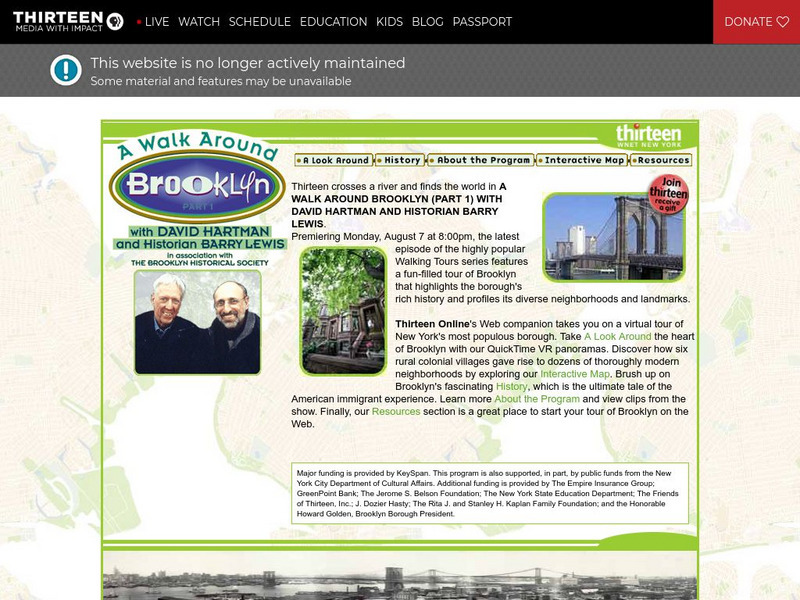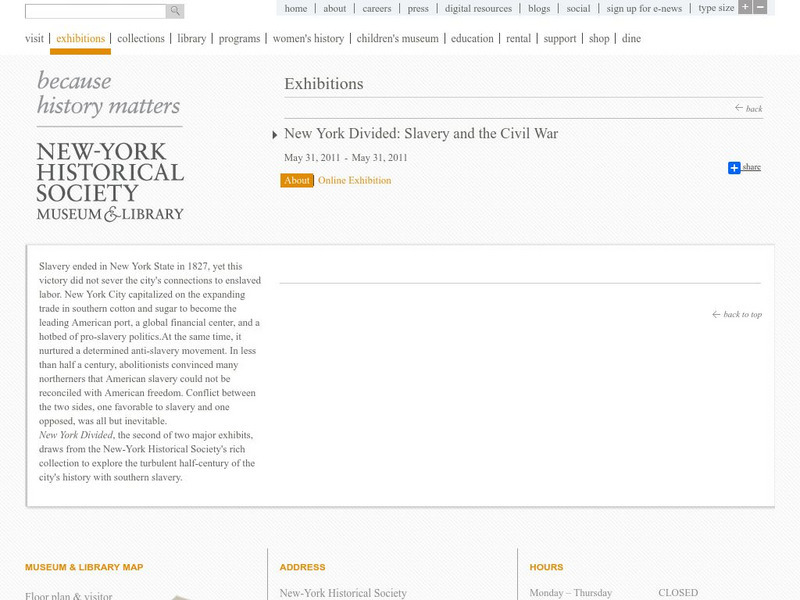Curated OER
The Roman Empire
Fourth graders identify the reasons behind the fall of the Roman Empire and describe the changes that occurred after the fall of the Roman Empire.
Curated OER
Around the World Calendar
Learners explore a country and its culture through its national landmarks. They use technology tools to research and communicate information. To demonstrate research skills, they use the Internet as well as print materials.
Curated OER
A Study of Cross-Cultural Connections
Ninth graders analyze connections between Asia and Europe in the pre-Renaissance period. They identify and analyze elements of Japanese and Chinese culture similiar to that of feudal Europe.
Curated OER
Scaling the Map
Students practice determining map distances using the map scales. They discover how much an area represents on the map in relation to the actual area. They decide on the best place to build their cavern.
Curated OER
The Rose Center
Students utilize Internet sites to improve word recognition, increase vocabulary and comprehension of the English language. They complete a worksheet stating facts from selected Internet sites. They write a composition about the web...
Curated OER
The Eerie Canal
Students discover bodies of water in the United States by investigating the Eerie Canal. In this U.S. Geography instructional activity, students discuss Lake Eerie and the canal that was built in order to transport goods. Students...
Curated OER
Rafe's Classroom Secrets
Students consider Rafe's classroom secrets and teaching methods.
Curated OER
Get the Word Out!
Students think about problems facing their community and about how to raise public consciousness. They also think about the importance and effectiveness of various forms of media in getting a message out to the public.
Curated OER
Show Me The Dinos
Students explore a site of numerous fossil excavations. Using an interactive quarry map, they locate dinosaur specimens and individual bones. In groups, students use "Show Me" cards to answer questions, compile information, and create...
Curated OER
Time Train
Students are read a short book "Time Train" by Paul Fleischman. Using the text, they identify the clues to let them know the train is traveling back in time. They make a time line of the trip and make a cutout of meat-eating and...
Curated OER
Priorities and Power: Migrants and Voting
Students examine the African-American migrants entry into the political process. They summarize their findings in a short essay.
Curated OER
Translating Traditions
Learners analyze art reflective of traditions and cultural heritage. In this art analysis lesson plan, students complete image based discussion.
Curated OER
The Ottoman Empire
Pupils compare the basic religious beliefs/and value systems of the three major religions that developed in the Middle East. Each group focuses on one of the religions, then reports to the rest of the class.
Curated OER
Cave Painting in the Ice Age
Students take notes and sketch during the Internet research. They take notes of the colors found in the cave paintings (black, browns, ochre, sienna). They create an initial full size comprehensive sketch on scrap paper and in their...
Curated OER
Smart Art
Students examine and practice the art of political cartoon-making by focusing on how and why they are so effective in making a political point.
Curated OER
Building Awareness of the Japanese American Wartime Experience
Pupils research the Japanese American World War II Camp Experience. They discuss the experience in the context of civil rights and the Bill of Rights.
Curated OER
"The Father of Lavish Advertising": P.T. Barnum
Students examine the life and work of P.T. Barnum. They discover his advertising techniques and business practices. They examine his use of people with disabilities for amusement.
Curated OER
Our State Road Trip
Learners take a virtual tour of the country of China instead of a state. Using the Internet, they examine the differences between a political and physical map and use latitude and longitude to locate specific places. They also research...
National Humanities Center
National Humanities Center: America in Class: America in the 1920s: New York City Subway Posters
The National Humanities Center presents collections of primary resources compatible with the Common Core State Standards - historical documents, literary texts, and works of art - thematically organized with notes and discussion...
PBS
Wnet: Thirteen: New York: A Walk Around Brooklyn
This is the web companion to a TV series of video walking tours of famous New York Neighborhoods. Take a virtual tour through the borough of Brooklyn, New York and see all the landmarks and treasures it is famous for. You can also read...
Other
New York Historical Society: New York Divided Slavery and the Civil War
Visit this virtual museum exhibit to learn about New York City's divided opinions about slavery before and during the Civil War. There are three themes covered: Pro-Southern City, Fighting Slavery, and Civil War. Students use a...
Smithsonian Institution
National Museum of American History: The Connected City: New York, New York 1920s
Exhibition highlights New York's harbor, with stories of the city as a hub of immigration, manufacturing, and culture.
Other
Museum of the City of New York: Life in New Amsterdam Educator Resource Guide
This page has a collection of downloadable lessons on New Amsterdam and New Netherland. The lessons look at native people, trade, slavery, religion, people, families, and children. They incorporate many primary source materials...
PBS
Wnet: Thirteen: Interactive Map: Manhattan in 1609: Dutch New York
Explore Dutch New York through this historical interactive map and learn what wildlife, landscape, and people lived there in 1609 compared with today. Click on 'Interactives' for additional resources, e.g., a 1626 letter from Peter...


